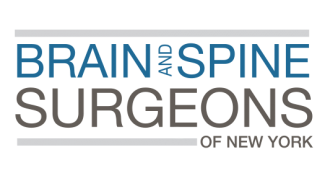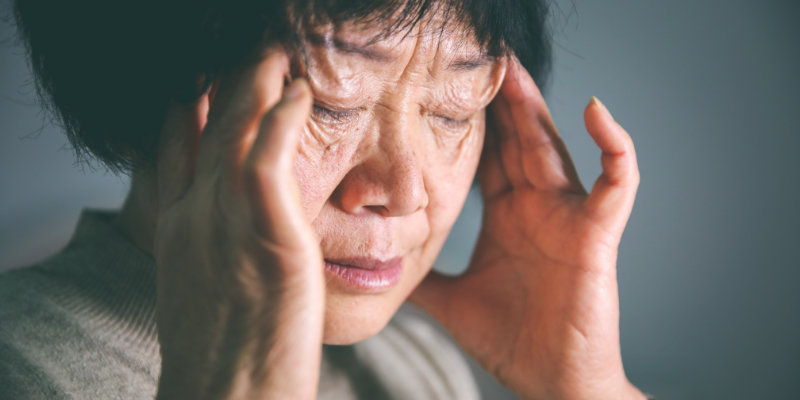
Case Study: Trigeminal Branch Stimulator Implant on 85-Year-Old Patient
The Problem
The patient was a 85-year-old female who began seeking care for chronic left-sided facial pain and headaches that began over 40 years ago after a car accident in 1989 that resulted in a head injury.
Since this time, the patient has suffered from daily pain that is typically worse in the morning and eases off to a smaller degree towards the end of the day. The patient states that cold compresses to her forehead usually helps alleviate a small fraction of the pain, but has not had any success with the use of medications.
The patient states that she has also tried several other options to alleviate her chronic pain including: laser treatments, acupuncture, dental procedures, and botox injections. All of these treatments had resulted only in limited transitory improvement.
The patient explains that her pain is a diffuse pressure with sharp pains and burning discomfort that waxes and wanes with intensity. The patient has no known triggers and has traveled far and wide for consults and has been given an array of diagnoses, including: trigeminal neuralgia, temporomandibular disorders, migraines, and atypical facial pain.
The Diagnosis
The patient appeared to have what used to be called atypical facial pain, which is now referred to as persistent idiopathic facial pain. As such, it is not surprising that medications for trigeminal neuralgia have not been of much benefit to the patient. Dr. Alain de Lotbinière planned to use a trigeminal branch stimulator to diminish this patient’s craniofacial pain and headaches. The patient agreed to a trial of trigeminal branch stimulation, the most reasonable therapeutic endeavor, to see whether or not the patient’s chronic pain was reduced. The trial proved to be successful, so the patient was scheduled for surgery to implant a permanent stimulation device, after the operation and its risks had been carefully outlined.
The Treatment
The patient underwent the surgery for the implantation of the leads and battery and was discharged home the same day.
The Outcome
The patient returned to the office to see Dr. de Lotbinière for multiple post-op appointments over a 6 month period. At her first post-op appointment, two weeks after surgery, the patient reported the stimulator was providing significant relief of her underlying pain and that the incisional discomfort was settling down on a day-to-day basis. Three months after surgery the patient reported that she experienced a marked reduction in her left-sided facial pain to the point that some days she has no pain whatsoever. Six months after the insertion of a trigeminal branch stimulator, the patient reported her left-sided facial pain was a fraction of what it once was and now, in her 80’s, had a new lease on life. No matter your age, treatments for a better quality of life are always welcome!
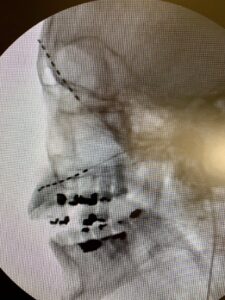
Trigeminal branch leads (lateral x-ray)
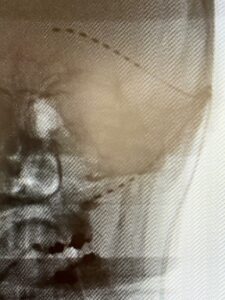
Trigeminal branch leads (frontal view)
Meet the Surgeon
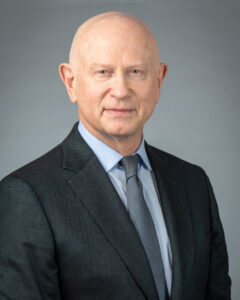 Dr. Alain de Lotbinière earned his undergraduate degree from Columbia University and completed his medical school and subsequent training at McGill University School of Medicine in Montreal, Quebec. He completed a fellowship at Addenbrooke’s Hospital in Cambridge, England. He is certified in neurosurgery by the Royal College of Physicians and Surgeons of Canada and by the American Board of Neurological Surgery. With a national reputation for properly diagnosing and surgically treating nerve disorders such as trigeminal neuralgia, Dr. de Lotbinière brings peace of mind to patients who have long searched for answers before coming to him. Click here to learn more about Dr. de Lotbinière.
Dr. Alain de Lotbinière earned his undergraduate degree from Columbia University and completed his medical school and subsequent training at McGill University School of Medicine in Montreal, Quebec. He completed a fellowship at Addenbrooke’s Hospital in Cambridge, England. He is certified in neurosurgery by the Royal College of Physicians and Surgeons of Canada and by the American Board of Neurological Surgery. With a national reputation for properly diagnosing and surgically treating nerve disorders such as trigeminal neuralgia, Dr. de Lotbinière brings peace of mind to patients who have long searched for answers before coming to him. Click here to learn more about Dr. de Lotbinière.

